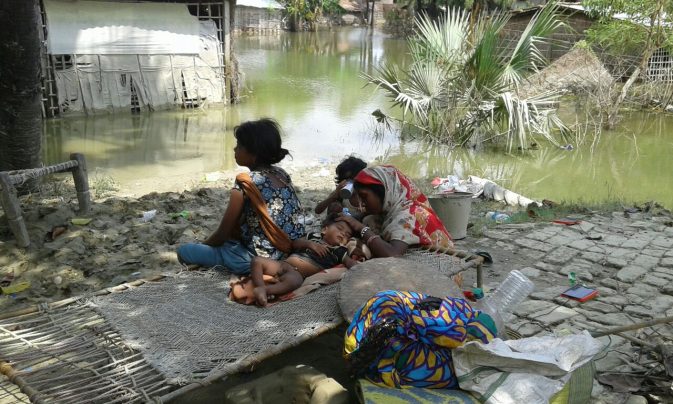Bihar is currently facing some of the most widespread and damaging floods witnessed in India in recent memory. To date there have been hundreds of people killed and 1.40 crore people affected by flooding across 18 districts in the state. Though the Indian Government and NGOs like ActionAid India have been hard at work to assist affected areas, additional support is urgently needed to address the pressing needs of the affected population and help them start along the road to recovery.
Villagers move to a safe place from floods in Gopalganj in Bihar on Sep 2, 200)
Impact of Floods
Floods in Bihar this August have exacted an enormous human cost on the state. Recent assessments suggest that 304 people have been killed so far, though the number of casualties could increase as heavy rainfall and flooding persist. The most affected district in terms of loss of life is Araria, where 57 people have perished, followed by Sitamadhi (31), West Champaran (29), and East Champaran (19).
State and national authorities estimate that there have been an additional 721,704 people displaced from their homes as a direct result of flooding.
| Affected Figures Particulars |
Figures |
| Number of Districts Affected |
18 |
| Number of Blocks Affected |
171 |
| Number of GPs Affected |
1965 |
| Total PopulationAffected |
126.87 Lakh |
| Total Population Displaced |
721704 People |
| Total Deaths |
253 |
Beyond causing widespread loss of life and displacement, the recent floods have also impacted people in affected areas in a variety of other ways. Thousands of hectares of cropland – which the majority of people in rural Bihar rely on for their economic livelihood – have been inundated
. Countless cattle, chickens, and other livestock have perished, further adding to the economic damage. Flooding has also made food supplies and clean drinking water harder to find, and moreover increased the risk of disease in affected districts.
These effects have been particularly severe for dalits, women, and other marginalized segments of society.
Government’s Response
Government actors have played an important role in responding to the crisis by:
- Organizing rescue operations that have involved a total of 1618 personnel from Nation and State Disaster Relief Forces, 620 staff from the Indian Army, and 92 motor boats.
- Constructing relief camps across Bihar which provide temporary shelter for 421,824 affected persons.
- Addressing food insecurity by setting up 2569 community kitchens and providing dry rations by airdrop.
Children looking at their home damaged in the floods in Narauli village of Muzzaffarpur district.
ActionAid’s Intervention Thus Far
ActionAid has also been actively working to address the situation in Bihar by:
- Conducting rapid needs assessments in the districts of West Champaran, East Champaran, and Darbhanga to determine the needs and vulnerabilities of communities affected by flooding.
- Supporting rescue operations in East Chamaparan by contributing volunteers and material resources.
- Distributing rations to more than 2500 dalits and members of minority communities in Sitamandhi, West Champaran, and East Champaran
- Disinfecting contaminated water sources in Dhaka block of East Champaran to reduce the risk of disease
- Coordinating with the Disaster Management Department and Inter Agency Group in Bihar to formulate an appropriate and effective overall emergency response
Immediate relief being provided to hundreds of affected families in East & West Champaran and Satamadi districts
What are the relief requirements?
Though existing relief efforts have helped to address some of the needs of flood-affected communities in Bihar, additional assistance in a variety of areas is necessary.
Action Aid, for its part,
is seeking material support to provide the following assistance to communities that are in dire straits, especially women who are living by themselves, disabled, aged and in an area that consists of peasant population, dependent on small scale farming and informal labour.
| Shelter |
Tarpaulin sheets of standard size for tents/temporary shelter |
| Four bamboo poles |
| Ropes (2 kilo coil) |
| Plastic sheet (5 by 6) for covering wet floors |
| Support for reconstruction of permanent houses. |
| Food Security |
Rice (30 kilo), chewda (5 kilo), oil (2 liters), 250 each of chilly power, dhaniya, mustard |
| Supplementary nutrition for pregnant & lactating women and children |
| WASH |
Halogen tablets for water purification |
| Hygiene and first aid kits (Five bathing soaps, ORS, Bandage, cotton, antiseptic lotion and cream, medicine for cough and cold, fever) |
| Decontamination of hand pumps & Construction of raised hand pumps |
| Bleaching powder |
| Water filters |
| NFIs |
Utensils (basic for a family of five) |
| Clothing for new born babies and children. |
| Two temporary cots/charpoy – (4 kilos of coir rope, 12 bamboo poles – measuring 5 feet each) |
| Mosquito nets (two sets), mosquito cream (odomos 100 grms four tubes) |
| Bed sheets (three) , plastic mat two (5 by 2 feet) |
| Livelihood Support |
5 – 10 kilos of paddy seeds, kilo of mustard seeds, assorted one kilo of vegetable seeds |
Contacts in ActionAid India : Ms.Sehjo Singh, Director Programs (sehjo.singh@actionaid.org) , M Number – 8800129222, Ravi SK , Head, Institutional Partnership Development (
ravi.sk@actionaid.org) – 9868216135, 011-40640560

